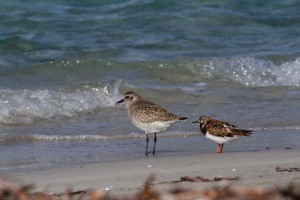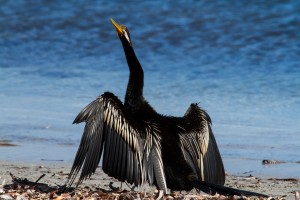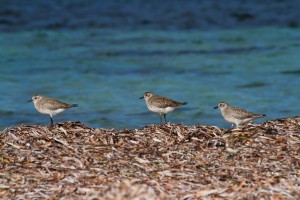

A very good turn out of 16 members attended our first field trip of 2015 which took in both beach and nature reserve at Woodman Point. While waiting for others to arrive I was pleased to see a Quenda cross the road and disappear into the dune vegetation near the beach. It is good to see them surviving in this environment. Also spotted was a large Golden Orb Weaver spider.

A Brown Goshawk was seen as we drove in to the car park. We met up at the car park near the Woodman Point Recreation Camp. We walked west along the beach on the south side of the point. Bird sightings initially included Silver Gulls and Crested Terns. A study of the shells on the shoreline revealed some information about marine species to be found in the waters of Cockburn Sound. The following species list was provided by Daniel Heald – assorted Pipis (Donax), Razor Clam (Pinna bicolor), Little Blue Periwinkle (Austrolittorina unifasciata ), some large Chitons, Jingle Shells (Anomia), oysters, blue mussels. Also prawns, rock crabs, ghost crabs (numerous holes in the sand on the beach), acorn barnacles, large tubeworms – probably the Red Fanworms ( Protula sp.), Lace ‘Coral’ (Bryozoans), Five-armed sea stars and also Banded Periwinkle (unifasciata Genus: Nodilittorina) and Limpets. Marine vegetation included Ulva lactuca (sea lettuce), Sargassum, Posidonia (strapgrass).

The South facing beach had substantial mounds of sea grass that had been washed up by the wind. A Bar-tailed Godwit was seen in flight and a small group of Grey Plovers was feeding amongst the sea grass. Two Ruddy Turnstones were also present. Red-capped Plovers and a Red-necked Stint were also active in this area. We then walked back along the north facing beach. Two male Australasian Darters came out of the sea and spread their wings to dry out after diving for food. This presented a nice photo opportunity. A small flock of Red Necked Avocets flew in for brief stopover but were soon on the wing again.

At the Cockburn Cement jetty we cut back across to the car park. In this area Rottnest Teatree (Melaleuca lanceolata) was in flower, as were Thick-leaved Fan Flower (Scaevola crassifolia) and Sea Rocket (Cakile maritama). In addition we found the usual dune plants inc. Spinifex, Marram, Berry Saltbush (Rhagodia baccata), Sea Spinach (Tetragonia decumbens) and Beach Evening Primrose (Oenothera drummondi). The invasive weeds – Sea spurge (Euphorbia paralias), and Fountain Grass (Pennisetum setaceum) were both thriving on the point, sadly.

We Then drove to the John Graham Recreation Reserve for a snack and cuppa before taking a walk through the Woodman Point Regional Park. Daniel made a quick check of the trees at the picnic area and found Dolichopodid Long-legged Predatory Flies, Pergid Sawflies, Tiphiid Flower Wasps, Tamopsis Two-tailed Spider eggs, and a tiny tree cockroach ootheca that had been parasitised and also Machaerotidae – tube spittlebugs – (because the nymphs live in calcareoustubes, rather than producing froth as in the other families of spittlebug froghoppers).

We added several bird sightings in this area, including Red Wattlebirds, Ringneck parrots, Galahs, Crested Pigeons and a Rainbow Lorikeet. Large numbers of Quandongs were seen, some were flowering. A large hollow in a Eucalypt was found to have a large number of Quandong seed casings each with a neat hole through which something had eaten the fruit inside. A rat?

A few of the smaller birds were found in the woodland including Splendid Fairy Wrens, Silvereyes, Singing Honeyeater, New Holland Honeyeater and Brown Honeyeaters. In total we spotted 31 bird species for the morning. Soon it was time to call it a morning and return to our cars. It had been a very enjoyable morning. Thanks again to Daniel for researching the marine species and the invertebrates.
Colin Prickett text and photographs.

